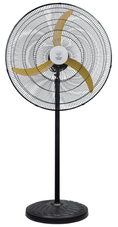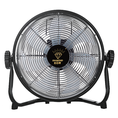Cooking is one of the oldest of technologies — and for obvious reasons: humans would never have survived (let alone thrived) without perfecting the art of feeding themselves. The basic idea of cookery — heating food to kill bacteria and make something nutritious and tasty — is fairly prehistoric: "food plus fire equals cooked food" is roughly how it goes. There's not an awful lot of difference between roasting a hunted animal on an open outdoor fire, as our ancestors would have done, and cooking it with electricity or gas in an oven, as we do today.
That's not to say there's been no progress in cooking technology. In the 20th century alone, ingenious inventors came up with two brand new forms of cooking. One, the microwave oven, uses high-energy radio waves to heat food quickly and efficiently in a fraction of the time you need with a conventional stove. The other, induction cooking, uses electromagnetism to turn cooking pans into cookers (creating heat energy inside the pan itself, instead of firing it in from outside), which cooks food more quickly and safely with less energy. Everyone knows about microwaves these days, but induction cookers are much less well understood. Let's take a closer look at exactly what they are, how they work, and whether they're better or worse than more familiar forms of cookery.
What is induction?
Before you can understand induction cooking, you need to understand induction. And the first thing you need to know is that "induction" is a shortened way of saying "electromagnetic induction." In a nutshell, induction means generating electricity using magnetism. It stems from the simple fact that electricity and magnetism aren't separate, unconnected things (as we originally learn in school) but two different aspects of the same underlying phenomenon: electromagnetism.
Induction in practice
You don't need to know much about electromagnetism to understand induction cookery—simply that a changing electric current can make magnetism and a changing magnetic field can make electricity. When you hear someone talking about induction, or something that uses induction, all it means is that magnetism is being used to generate electricity.
A common use for induction is in electric toothbrushes, which have one or two rechargeable batteries packed inside. The trouble with electric toothbrushes is that they get wet, so they need to have completely sealed plastic cases to keep their mechanisms safe and dry. But that creates a different problem: if they're completely sealed against water, how can you get electricity inside to recharge them? A conventional charger socket would be an open invitation to water as well. That's where induction comes in. When your toothbrush battery runs flat, you sit it on a little plastic charger unit to recharge it. Although there is no direct electrical connection between the toothbrush and the charger (both are made of plastic), electromagnetic energy flows from the charger into the toothbrush battery by induction, straight through the plastic that separates them: a coil of wire in the charger produces a magnetic field that induces an electrical current in a similar coil in the base of the toothbrush. You can find out more (and see some diagrams of exactly how it all works) in our main article on induction chargers.
How does an induction cooktop work?
An induction cooktop (a cooktop is called a "hob" in European countries) is simply an electromagnet you can cook with. Inside the glass cooktop, there's an electronically controlled coil of metal. When you turn on the power, you make a current flow through the coil and it produces a magnetic field all around it and (most importantly) directly above it. Now a simple direct electric current (one that's always flowing in the same direction) produces a constant magnetic field: one of the laws of electromagnetism is that fluctuating magnetism is produced only by a constantly changing electric current. So you have to use an alternating current (one that keeps reversing direction) to make a fluctuating magnetic field that will, indirectly, produce heat. And that's all that an induction hob does: it generates a constantly changing magnetic field. It does not generate heat directly. You can put your hand on top of it and you won't feel a thing. (Warning: Don't ever put your hand on a cooktop that has recently been used for cooking because it may have become dangerously hot from the cooking pan that's been standing on top of it.)
When you stand a suitable cooking pan on top of an induction cooktop that's powered up, the magnetic field produced by the cooktop penetrates the metal of the pan. So we have a fluctuating magnetic field moving around inside a piece of metal (the base and sides of the pan)—and that makes an electric current flow through the pan too (that's all that induction means). Now this is not quite the same as the electric current that flows through a wire, carrying electrical energy in a straight line from (say) a battery to a flashlight bulb. It's a kind of whirling, swirling electric current with lots of energy but nowhere to go; we call it an eddy current. As it swirls around inside the metal's crystalline structure, it dissipates its energy. So the metal pan gets hot and heats up whatever food is inside it, first by conduction (it passes its heat energy directly to the food) but also by convection (liquid food rises and falls in the pan carrying heat with it). Read more about heat transfer in our main article about heat energy.
Advantages of induction cooktops
Efficiency and speed
A traditional cooker generates heat energy some distance from the cooking pot or pan and attempts to transport as much of that energy into the food as possible—with varying degrees of success. If you've ever cooked food on a campfire, you'll know that it's great fun but takes forever. The main reason is that a huge amount of the energy you produce on an open fire is radiated out into the atmosphere; great for ambience, but very slow and inefficient. Even cooking at home can be quite inefficient: you're wasting energy heating the cooktop and (in the case of a stove with a roaring gas flame) the air all around your pots and pans. With induction cooking, the heat is produced in the pan, not the cooktop, and much more of the energy goes into the food. That's why induction cooking is more energy efficient than most other methods (around 84 percent compared to 71 percent for a traditional cooktop). Induction cooking also gets energy to the food more quickly, because pans that get hotter faster cook faster. Typically, it's around 25–50 percent faster than other methods, which can be a big plus for restaurants if it helps get dishes to the table more quickly.
Convenience, control, and safety
Induction cookers are usually built into ceramic or glass cooktops (similar to halogen cooktops), which are very easy to keep clean with just a quick wipe. The magnetic fields they produce make heat appear in the pan almost instantly—and they can make it disappear instantly too. That's very different from traditionally heated pans, which take a while to get hot, so there's a greater risk of burning your food if you don't pay attention!
You can turn the heat up or down with as much speed and control as a gas cooker (unlike a traditional electric cooktop, which takes some time to heat up or cool down). Even so, it's a different form of cooking and it does take some getting used to: you have to learn which numeric value on the dial corresponds to the amount of heat you need, and that takes practice (to be fair, that applies to any new form of cooking you might try). On the other hand, induction cooktops are easy to switch on or off automatically, so some feature built-in timers, built-in temperature sensors, and even remote control from simple smartphone apps.
There's no open flame on an induction cooktop and (until there's a cooking pan actually present) no heat to burn you. Heat appears only when the cooking pan is in place — and the cooktop itself can never get any hotter than the pan sitting on top of it. Electronically controlled cooktops can detect whether pans are standing on them and how much heat they're producing, and most will cut the power out automatically if they're left on by mistake or if a pan starts to boil dry. Induction cookers built into ceramic cooktops are only a couple of inches thick so they can be fitted at any height (good for disabled people in wheelchairs who might want a low-level kitchen).
Drawbacks of induction cooktops
Until recently, cost was the biggest disadvantage: a typical induction cooktop could be two or three times more expensive than an ordinary electric or gas cooktop and, even though you'd save energy, the energy savings weren't usually significant enough to pay back the difference. The price of induction cooktops has now fallen significantly and there's much less difference in cost compared to ordinary ceramic cooktops. Even so, don't buy an induction cooker with the expectation that you'll see your energy bills fall: cooking represents only a small fraction of the total energy most people use at home and any savings you do make (though welcome and important for the environment) will be modest.
Another drawback is that induction cooking only works properly with cooking pans containing iron — the only metal that efficiently produces electrical (eddy) currents and heat from magnetic fields. Copper and aluminum pans and glass cookware don't work. Iron-based pots and pans compatible with induction cooktops are widely available, so the cookware issue is only really a problem if you have a large collection of existing, unsuitable cookware you're not prepared to replace. Indeed, some people even see it as an opportunity to upgrade. If you are going to replace your cookware, you could investigate "cool-touch" pots and pans made specifically for induction. Some have insulated outer bodies (made from ceramics or heatproof plastics) that stay relatively cool to the touch, with lumps of stainless steel or iron embedded in them to pick up the magnetic field from the cooktop and turn it into heat. Some have built-in temperature sensors that help the cooktop to regulate the power it needs to supply, which also enables automatic, remote control from things like smartphone apps.
















